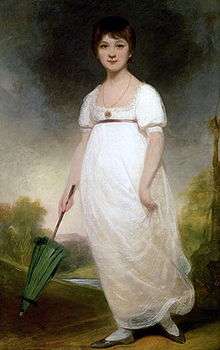The Rice portrait

The Rice portrait is believed by the owners to be of Jane Austen and painted by Ozias Humphry in 1788 when Austen was 13. Experts at the National Portrait Gallery (and elsewhere) have disputed this, suggesting that the painting dates to the early 19th century and thus cannot be of Austen, or painted by Humphry.
History
The Rice portrait is believed by the family owning it to have been painted by Ozias Humphry in 1788 when Jane Austen was 13.[1] The owners believe it was commissioned by Austen's great uncle, Francis Austen during a visit.[2] It was originally attributed to Johann Zoffany. In 1884, it was used as an illustration in a collected edition of her letters. It was photographed by Emery Walker in about 1910. The National Portrait Gallery, London attempted to purchase the work in the 1930s. In 1948, the Austen scholar, R.W. Chapman, rejected the identity of the sitter based on costume evidence.[3] In 1994, the portrait was exhibited at Olympia. Henry Rice, the then owner, offered it to the National Portrait Gallery, but they were not willing to buy it.[4] The portrait was given an export licence in 2007 on the basis that it was not of Austen. It was put up for auction at Christie's in New York, in 2007 but failed to sell.[5]
Provenance
The most significant evidence for the authenticity of the portrait is its provenance. The portrait passed from Thomas Austen (grandson of Francis) to a relative, Elizabeth Harding-Newman, in 1818, the year after Austen died. It was described as "the novelist, Jane."[6] It was inherited by her stepson and then by the reverend John Moorland Rice. It descended through the Rice family to its present owner.
Costume
The most significant evidence for rejecting the authenticity of the portrait is the style of the costume. In 1948, Dr R.W. Chapman disputed its authenticity on costume grounds. At that time, costume historians believed that the high waist and sash is a style that did not become popular in England until around 1805 (when Austen was 30 and Humphry had gone blind and was no longer painting).
The ability to date costume sufficiently accurately is disputed by other costume historians (such as Professor Claudia Johnson of Princeton). Lilian and Ted Williams argue that there are English examples of this costume style from the 1780s and 1790s, though some of the examples shown on the website dedicated to the Rice Portrait are in paintings that are themselves of disputed or indeterminate date.[7] It is also pointed out that the Austen family had connections with France, where this fashion appears earlier than it does in England.
Inscriptions
In 2012, research and forensic work was undertaken using digital analysis of photographs in the Heinz Archive & Library taken prior to a later poor cleaning and over-painting of the portrait. This digital enhancement is said to show that the signature of Ozias Humphry, and the name Jane Austin is visible on the photograph .[8] These inscriptions were apparently lost when the painting was over-zealously restored. This research work was validated by the English-based company Acume Forensics.
However, Jacob Simon of the National Portrait Gallery pointed out that the inscriptions were not noticeable in the Walker photograph, nor when the portrait was photographed prior to cleaning in 1985.
References
- ↑ Evening Standard 2007
- ↑ The Jane Austen Centre
- ↑ Art Daily News
- ↑ Reuters
- ↑ Jane Austen society of America
- ↑ from the 2007 auction catalogue
- ↑ Rice Portrait Website
- ↑ Daily Mail report